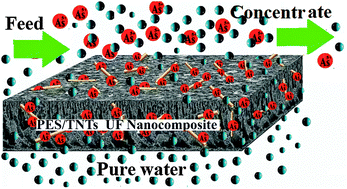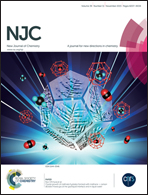Arsenate removal from contaminated water by a highly adsorptive nanocomposite ultrafiltration membrane
Abstract
In order to overcome the limitations of the adsorption process, a new type of nanocomposite ultrafiltration (UF) membrane consisting of polyethersulfone (PES) and titanate nanotubes (TNTs) was fabricated in this work via the phase inversion technique and used for adsorptive arsenate (As(V)) removal. The effects of impregnating TNTs on the structural morphology, hydrophilicity, porosity, pure water permeability and As(V) uptake capacity of the nanocomposite membranes were studied for different weight ratios of TNT:PES in the membrane matrix, ranging from 0 to 1.5. Of the membranes studied, an As(V) uptake capacity as high as 125 mg g−1 was achieved using the membrane containing the highest amount of TNTs (designated as PES/TNT 1.5) and the performance of this membrane is comparable to most of the available adsorbents and other As removal systems. Increasing the TNT:PES weight ratio from 0 to 1.5 led to an increase of membrane pure water permeability from 39.4 to 1250 L m−2 h−1 bar−1 with the water contact angle decreased from 69.5° to 5.2°. The experimental findings from the continuous UF process revealed that the nanocomposite membrane of the highest TNT content could generate a permeate of high quality to meet the maximum As level set by the World Health Organization (WHO), i.e. <10 μg L−1. Furthermore, the adsorptive performance of the nanocomposite membrane could be easily regenerated using alkaline solution.


 Please wait while we load your content...
Please wait while we load your content...